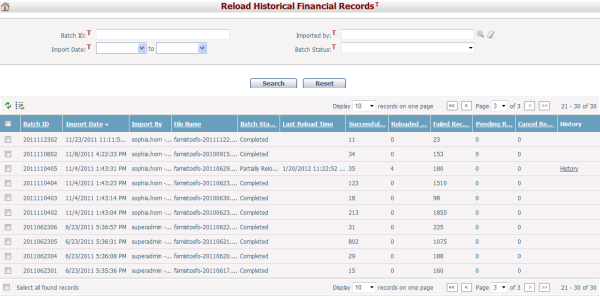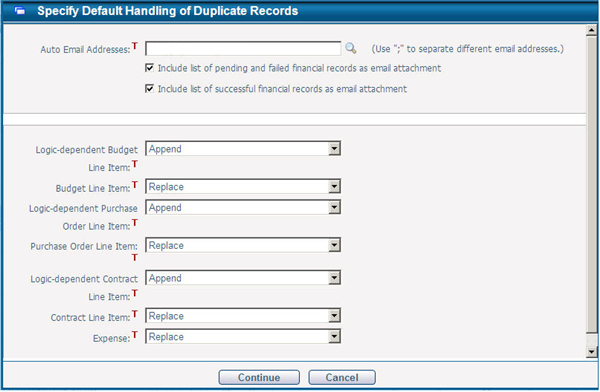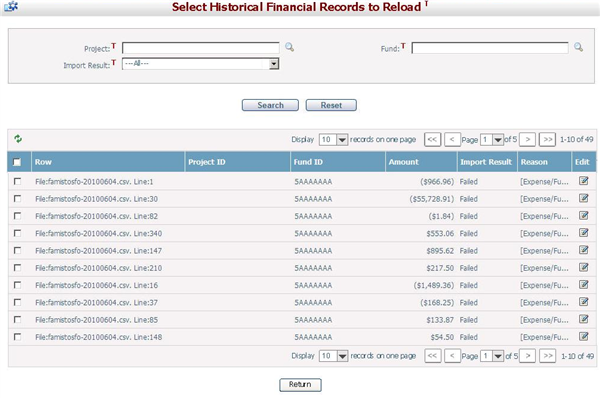Navigate Here: Financials > Financial Integration > Reload Historical Financial Records
You can reload financial records on the Reload Historical Financial Records page.

A brief summary of each financial integration batch is displayed in the table. The summary includes Batch ID, Import Date, Imported By, File Name, Batch Status, Last Reload Time, Successful Records, Reloaded Records, Pending Records, Cancel Records, and Failed Records. You can sort the batch summaries by clicking the linked column headers. If there are too many records to display on one page, you can use the navigation control to view another page.
Last Reload Time, if applicable, indicates that the batch was once reloaded, and gives the date/time when the last reload was conducted. If the batch has never been reloaded, this field will be blank.
Reloaded Records, if applicable, indicates the UTD number of reloaded records in the batch. If the batch has never been reloaded, this number will be “0”.
Canceled Records is only applicable to the batches in which all imported financial data were deleted in CIPAce. The batch status will be Canceled.
You can quickly find the batch summaries you want by using the search function. Enter search conditions in the search fields and click the Search button. The batch summaries will be filtered and the table will show the records that match the search conditions. Click the Reset button to clear the search conditions.
If a batch has been reloaded, you can view the reload history of the batch by clicking its History link. The system will then open the View Reload History screen in a new window.

You can view detailed information of the new batch by clicking the View New Batch link. The system will open the Financial Integration Result Management screen of this new batch in a new window.
You can select a batch or multiple batches to reload and then click the Reload icon ![]() . By doing so, all failed (other than failed due to unknown transaction type), canceled, and pending financial records in the selected batch(es) will be reloaded. The system will pop up a window asking you to select the default handling option for the duplicate records. There are four financial transaction types available for duplicate record handling configuration: Budget Line Item, Purchase Order Line Item, Contract Line Item, and Expense. Each transaction type has two financial logic types:
. By doing so, all failed (other than failed due to unknown transaction type), canceled, and pending financial records in the selected batch(es) will be reloaded. The system will pop up a window asking you to select the default handling option for the duplicate records. There are four financial transaction types available for duplicate record handling configuration: Budget Line Item, Purchase Order Line Item, Contract Line Item, and Expense. Each transaction type has two financial logic types:
Logic-Dependent: Integration logic is based on customized financial integration logic when a certain condition is met during integration.
Not Logic-Dependent: Integration logic is based on default CIPAce financial integration logic.
The default duplicate record handling methods available for selection include:
Ignore: Ignore the new financial data record.
Append: Add the new financial data record to the existing record.
Replace: Replace the existing financial data record with the new record.
Create New: Create a new financial data record and leave the existing record intact.
Manually: Leave the duplicate records to the user to process on the Financial Integration Result Management screen.
Budget Adjustment, Purchase Order/Contract Change Order transactions shall only be appended to existing matching Budget Line Items and PO Line Items, respectively. After the default handling of duplicate records are specified, click the Continue button to proceed.

Alternatively, you can select a batch or multiple batches to reload and click the Select Records to Reload icon ![]() . By doing so, you can select financial records from the selected batch(es) for reloading. The system will then go to the Select Historical Financial Records to Reload screen.
. By doing so, you can select financial records from the selected batch(es) for reloading. The system will then go to the Select Historical Financial Records to Reload screen.

All failed (other than the Unknown transaction type failed records), pending, and canceled financial records in the selected batch(es) will be listed on this screen.
A brief summary of each financial record is displayed in the table. The summary includes: Row, Project ID, Fund ID, Amount, Import Result, and Reason. If there are too many records to display on one page, you can use the navigation control to view subsequent pages.
You can quickly find the financial records he/she wants by using the search function. Enter search conditions in the search fields and click the Search button. The financial records will be filtered and the table will show the records that match the search conditions. Click the Reset button to clear the search conditions.
You can select the financial record(s) for reloading and click the Reload icon ![]() . The system will pop up a window, asking you to select the default handling option for the duplicate records, and then the process will continue as aforementioned.
. The system will pop up a window, asking you to select the default handling option for the duplicate records, and then the process will continue as aforementioned.
Once the reload process is completed, the financial data will be auto-synchronized with the analytics database.